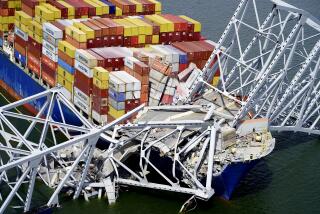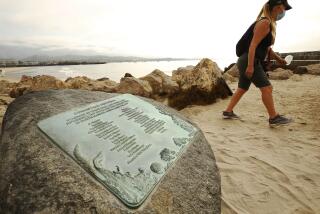Safety systems were bypassed, rig worker says
Reporting from Kenner, La., and Los Angeles — Key safety systems were bypassed or disabled on the doomed Deepwater Horizon drilling rig — some for months or years — a top technician on the vessel testified Friday, as offshore cleanup crews hurried toward port ahead of a tropical storm system.
In testimony in the third round of investigative hearings in Louisiana, a rig technician described an operation in which alarm systems and safety devices were turned off, computers didn’t work and maintenance was long overdue.
“The rig was in very bad condition,” said Mike Williams, a chief electronics technician who worked for rig owner Transocean Ltd. aboard the Deepwater Horizon.
At one point, Williams testified, he was chewed out by a superior who noticed Williams had activated a gas safety valve that had been placed in bypass mode.
“ ‘The damn thing has been in bypass for five years. Why did you even mess with it?’ ” Williams recalled being told by Mark Hay, a Transocean subsea supervisor. “And he said, ‘As a matter of fact, the entire fleet runs them in bypass.’ ”
According to Williams, the pressure regulator valve, which automatically cuts off natural gas flow when it reaches a certain pressure point, was in bypass mode when a burp of gas shot up into the rig from the oil well beneath and exploded, killing 11 men and setting in motion the worst offshore oil spill in U.S. history.
As testimony was underway, many of the response vessels that have been clustered around the spill site were on the move. Tropical Storm Bonnie, which weakened into a tropical depression as it blew across Florida into the Gulf of Mexico on Friday, was expected to hit the spill area Saturday.
Retired Coast Guard Adm. Thad Allen, who is in charge of the federal response to the spill, said the rigs drilling relief wells would retreat to safer waters, delaying that operation for days. The last vessels to leave the spill site will be those running the underwater surveillance robots monitoring the damaged well, which will remained sealed during the storm. If the seas don’t grow too rough, the sentry robots could remain.
The Coast Guard will conduct flights over the spill area and study satellite images for signs of a new leak from the BP well, which had been spewing as much as 60,000 barrels of oil a day into the gulf until it was capped a week ago.
Testifying at a U.S. Coast Guard- Interior Department investigation into the cause of the disaster, Williams said a fire alarm system on the rig had been disabled. “I discovered it was ‘inhibited’ about a year ago,” Williams said. “The explanation I got was that, from the [offshore installation manager] down, they did not want people to wake up at 3 a.m. due to false alarms.”
In the “inhibited” mode, the control panel would indicate a problem, but would not sound a general alarm throughout the rig. Williams said he repeatedly complained, to no avail, about the practice. The last time he complained, he said, was three days before the deadly April 20 explosion.
Responding to Williams’ testimony in a statement, Transocean said the Deepwater Horizon “had hundreds of individual fire and gas alarms, all of which were tested, in good condition, not bypassed and monitored from the bridge.”
The company said the general alarm was controlled by a worker on the bridge and sounded from there when conditions called for it. “This is an option on each individual vessel designed to prevent the general alarm from sounding unnecessarily…. Repeated false alarms increase risk and decrease rig safety.”
Transocean also released a three-page inspection report, dated a week before the disaster, that listed Deepwater Horizon’s fire and gas detection systems as operating and “in good condition.”
Williams said the primary computer used to control all rig drilling functions routinely crashed and had to be restarted. “It turned into a blue screen. You’d have no data coming through,” he testified.
He said replacement hard drives were ordered, as well as an entire new computer system. But the problems weren’t resolved, partly because technicians couldn’t get the old software to work on the new hardware. “We were limping along with what we had,” Williams said.
Another problematic system tracked maintenance aboard the floating oil rig. Sometimes the computer called for maintenance to be done on equipment that was not aboard the Deepwater Horizon, he said. Other items aboard the rig that did need maintenance weren’t on the computer system.
Echoing the testimony of survivors in earlier hearings, Williams described a scene of chaos after the explosion ripped through the rig, which had been drilling the deep-sea well about 50 miles off the Louisiana coast and sealing it in preparation for a production rig to be moved into place.
He was thrown across his office, and crept through the dark with a pen flashlight clenched between his teeth before a second blast slammed him against a wall.
Bleeding from an arm and a leg, he crawled through the engine control room and over the bodies of two men, he said. Once outside, he turned and saw part of the rig had vanished.
Later, after the rig captain told everyone to abandon ship, Williams jumped, splashing into toxic goop coating the water. He started to swim, then fell into a daze. “I thought that was it, I had died.”
Williams said he revived, swam toward a faint voice calling, “Over here, over here,” and was hauled into a life raft.
Lin reported from Kenner and Boxall from Los Angeles.
More to Read
Sign up for Essential California
The most important California stories and recommendations in your inbox every morning.
You may occasionally receive promotional content from the Los Angeles Times.












